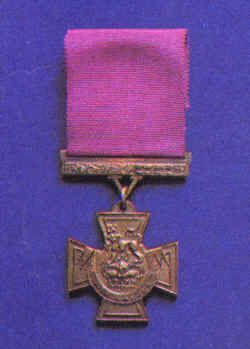Only 3 men have won two VC’s in the history of the medal. The double VC holders were Surgeon Captain Arthur Martin-Leake, Captain Noel Chavasse and Captain Charles Upham.
Surgeon Captain Arthur Martin-Leake won his first VC in 1902 during the Boer War. He treated a wounded soldier just 100 metres from the enemy’s line. He was shot and wounded by the Boers but continued treating men until he collapsed with exhaustion, having first ordered that the wounded received water before he did. Martin-Leake’s second VC was won in 1914 near Zoonebeke in Belgium. He was awarded his second VC as a result of showing conspicuous bravery near enemy lines rescuing men while under constant fire. His commanding officer wrote in his recommendation “His behaviour on three occasions when the dressing station was heavily shelled was such as to inspire confidence both with the wounded and the staff. It is not possible to quote any one specific act performed because his gallant conduct was continual.”

Surgeon Captain Arthur Martin-Leake died in 1953 aged 79.
Captain Noel Chavasse won two VC’s in World War One. Qualified as a doctor, Chavasse joined the Royal Army Medical Corps (RAMC) when World War One broke out. His unit of the RAMC was attached to 10thBattalion King’s (Liverpool) Regiment which fought at the Battle of Hooge near Ypres in 1915. The ferocity of this battle was such that out of 900 men in the 10th battalion just 140 men and 2 officers survived. For his gallantry, Captain Chavasse was awarded the Military Cross. On Day 1 of the Battle of the Somme, the battalion was ordered to attack the fortified village of Guillemont. Along with many other units, the 10thbattalion suffered major casualties. Chavasse tended as many of the wounded as he could even into the night- time. He was hit by shrapnel twice and on one occasion carried a wounded man 500 metres back to safety. Chavasse also collected as many dog tags as he could of men killed in the attack. The citation for his first VC stated: “Altogether he saved the lives of some twenty badly wounded men, besides the ordinary cases which passed through his hands. His courage and self-sacrifice were beyond praise.” Chavasse received his VC from King George V in February 1917.
In July 1917, Chavasse saw action at the Battle of Passchendaele. With his men, he set up an advanced first-aid post in a captured German dugout. The Germans shelled this position and Chavasse was hit in the head, fracturing his skull. He received treatment for this serious injury and despite advice to the contrary, returned to his first-aid post. Further shelling led to two more head injuries. On his orders, stretcher-bearers took other wounded men back to relative safety, as Chavasse believed that he had to stay where he was to support men who were there. On August 2nd, 1917, another shell blast resulted in a severe stomach wound, which required treatment at a casualty clearing station. However, the wound was so severe that Chavasse died on August 4th aged 32. The citation for his second VC stated: “Though severely wounded early in the action whilst carrying a wounded soldier to the dressing station, he refused to leave his post, and for two days not only continued to perform his duties but went out repeatedly under enemy fire to search for and attend to the wounded who were lying out. During these searches, although practically without food, he assisted to carry a number of badly wounded men over heavy and difficult ground. By his extraordinary energy and inspiring example he was instrumental in rescuing many who would have otherwise undoubtedly succumbed under the bad weather conditions.”
Chavasse was buried in the military cemetery at Brandhoek in Belgium. His headstone is the only one in the world engraved with two VC’s.
Captain Charles Upham won his first VC for outstanding leadership and courage during fighting in Crete in May 1941. Despite being wounded by a mortar shell, he carried a wounded man back to safety. Eight days after this, he killed twenty-two Germans with a sub-machine gun during an attack.
In 1942, Upham, fighting in North Africa, captured a German position, destroying a tank and several vehicles with grenades despite his injuries. His arm had been shattered by a machine gun but he only stopped fighting when blood loss made him faint. Only then did he have his wounds dressed. Regardless of his wounds, Upham stayed with his men, continued to fight and suffered further injuries.
Captured during the war, Captain Charles Upham was sent to Colditz where he spent the rest of the war as a
He died in New Zealand in November 1994, aged 86.
